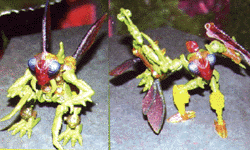 BEAST WARS: TOY
REVIEW
BEAST WARS: TOY
REVIEW
There are over 2000 species of this large (about 5 centimetres long), slow-moving insect. All Mantids are characterised by an elongated prothorax (first thorax segment) and front legs modified so that the tibia of the lower leg fits into a spined groove in the femur of the upper leg. The mantid, which feeds exclusively on living insects, seizes its prey in a vicelike grip. When alarmed, the mantid assumes a "threatening" attitude by raising and rustling its wings (if it is a winged species) and often displays bright warning colouration. Usually found among vegetation rather than on the ground, a mantid may be disguised to resemble green or brown foliage, a dried leaf, a slender twig, a lichen, a brightly coloured flower or an ant. This camouflage hides it from predators and also makes it inconspicuous as it stalks or awaits prey. The female, who often eats the male after they mate, lays about 200 eggs in a large cocoon-like capsule (called the ootheca), which serves to protect the eggs during adverse weather conditions or from enemies. The nymph, which lacks wings but otherwise closely resembles the adult, emerges with other nymphs; they often end up eating each other.
The majority of mantid species live in tropical or sub tropical regions. The most widespread genera in Europe is the Mantis, Mantis religiosa, followed by Ameles, Iris and Empusa. Some North American mantids include the Stagmomantis, Litaneutria (the only mantid native to Canada), Thesprotia and Oligonicella. Mantis religiosa, Iris oratoria, Tenodera angustipennis and Tenodera aridifolia sinensis are not native to North America, but were introduced by European settlers. The most familiar mantid in North America is the Chinese Mantid, which is native to many parts of eastern Asia and is the largest mantid in North America, with length ranging from 7-10cm.
The name mantis, meaning "diviner," came from the ancient Greeks who believed that the insect had supernatural powers. The name mantid, meaning "soothsayer," reflects this belief. Numerous myths and legends are associated with the mantid because it can remain motionless or sway gently back and forth, with head raised and front legs outstretched in an apparent attitude of supplication. According to Western superstition, the brown saliva of the mantid can cause blindness in a human, and if a mantid is eaten, can kill a horse or mule. In Chinese superstition, the mantid is also a symbol of misfortune. However, it is also the patron animal to the Bazhua martial art, Tanglang Quan (Praying Mantis Kung Fu). Legend has it that a monk spent years observing and studying the movements of the mantid when it attacked other insects. He then adapted these movements into a fighting style.
Although names such as Gottensanbeterin (German), prie-Dieu (French), prega-Diou (Provençal) and "god-horse" (West Indian) all suggest piety, being such ferocious carnivores, perhaps the name Preying Mantis would be more appropriate.
Like snakes, lizards also have ectodermal scales, paired with male copulatory organs (hemipenes) and flexible skulls. Typical lizards have moderately cylindrical bodies, four well-developed legs, a tail slightly longer than the head and body, and movable lower eyelids. They range in size from about 3 to over 300 centimetres, but most are about 30 cm long. Ornamentation includes crests on the head, back or tail, spines, brightly coloured throat fans and throat frills.
Like fish and amphibians, lizards are cold-blooded animals; i.e., the temperature of the environment regulates their body temperature, although a few species have the ability to store the Sun's warmth for extended periods of time. Most lizards lay eggs, which they bury in the ground. The embryo forms a special tooth for rupturing the shell. A number of species, however, bear live young. Most species feed on insects and rodents, but some, such as the iguana, are herbivorous.
Bibliography: Encyclopaedia Brittanica